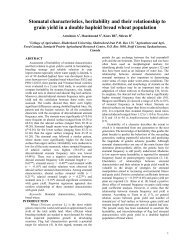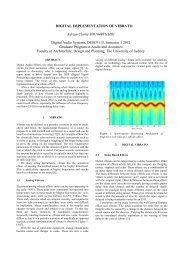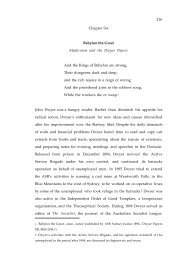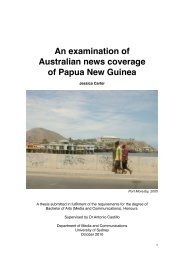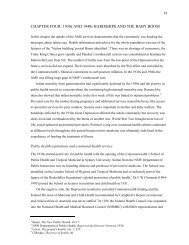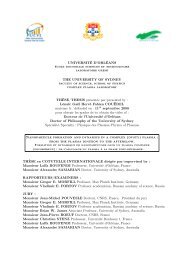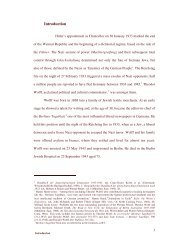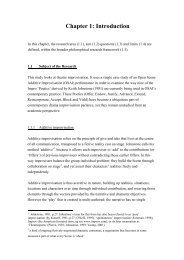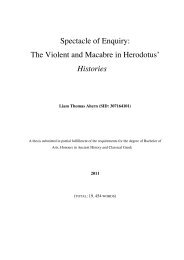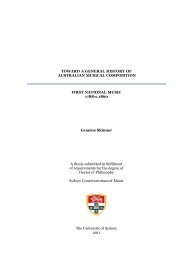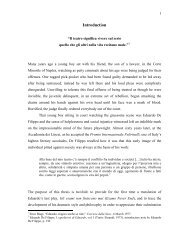journal of digital research & publishing - The Sydney eScholarship ...
journal of digital research & publishing - The Sydney eScholarship ...
journal of digital research & publishing - The Sydney eScholarship ...
You also want an ePaper? Increase the reach of your titles
YUMPU automatically turns print PDFs into web optimized ePapers that Google loves.
1 P M J O U R N A L O F D I G I T A L R ESEARCH & P UBLISHING<br />
blogs, Facebook status updates, video streaming – provides a ‘hypertrophy <strong>of</strong> memory,<br />
which can cause the incapacity <strong>of</strong> people to select and give importance to what they record’.<br />
<strong>The</strong> content published on these sites <strong>of</strong>ten gives cause for questioning. Yet, information<br />
about personal relationships, for example, features frequently on Facebook news feeds.<br />
`6&$*&'7**$)#%&6+36&*70%&(*%>*&87&"76&H"7G&+7G&67&>%*6>$56&355%**&67&6+%$>&'>74#%*S&6+%>%)9&<br />
exposing content to unintended audiences. Others purposely leave access open despite<br />
privacy standards required to ‘encourage safe participation’ (Strater and Richter 2007<br />
p.157) in these sites. <strong>The</strong> point <strong>of</strong> selfdisclosure, after all, is to invite the audience into the<br />
private sphere.<br />
As Strater and Richter (2007) point out, ‘the disclosure <strong>of</strong> personal information…<br />
support[s] online popularity and perceived social attractiveness’ (p.57). So, users make<br />
choices in disclosing private information in order to establish themselves in a certain<br />
position in a social setting, in this case social networking usergenerated sites.<br />
Alternatively, Taddeo (2009) claims that people ‘seem to lose the difference between<br />
public and private spheres <strong>of</strong> memory...even between what must be remembered [or<br />
published] and what not’ (p.130). This implies the use <strong>of</strong> UGM technologies causes people<br />
67&356&$"&3&5%>63$"&G39S&3"8&6+36&6+$*&53"&)%&'>%8$56%8&)9&*5$%"6$45&*6(89M&<br />
Claims like these base themselves on the assumption that human beings’ actions are<br />
governed by a particular force within them, <strong>of</strong>ten labelled the ‘mind’. This argument is<br />
C3G%8&)%53(*%&$6&$*&$##7,$53#&67&366>$)(6%&+(03"&356$7"&67&3&D7>5%&6+36&53""76&)%&7)*%>I%8a&$6&<br />
also takes choice away from a person and, along with it, their accountability for the choices<br />
they make (Spillane 2006).<br />
!"#$%&#&$'$()*+,-.*+,/0&$1#)&2#.+,3#<br />
B+%& _*%*& T& =>36$4536$7"*& 6+%7>9& $*& 3& 57007"& 6+>%38& 35>7**& *6(8$%*& $"& (*%>],%"%>36%8&<br />
media. According to U&G, people choose a medium based on the likelihood <strong>of</strong> it meeting<br />
their ‘needs’ (Blumler and Katz 1974). <strong>The</strong> majority <strong>of</strong> the documentation reviewed for this<br />
paper was based on the U&G model.<br />
U&G is a psychological communication perspective that proposes that ‘active audiences<br />
*%#%56&'3>6$5(#3>&0%8$3&67&*36$*D9&D%#6&"%%8*S&G+$5+&3>%&$"C(%"5%8&)9&3&"(0)%>&7D&*75$3#&<br />
and psychological factors that affect media selection and use’ (Rubin 1994). Its main<br />
objectives focus on the correlation between media and ‘needs satisfaction’; understanding<br />
the motives behind media behaviour; and identifying the functions or consequences<br />
15






